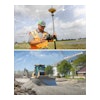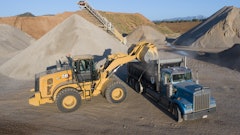
Trimble today released 10 predictions for the construction industry for 2025. These predictions cover several technological trends, from artificial intelligence (AI) to reality capture. See what these in-house experts had to say about the coming year.
1. AI and Machine Learning (ML)
59% of respondents of a recent Trimble survey said that AI and ML will be one of the biggest trends in 2025, and for good reason – it has and will continue to transform the construction industry due to the many efficiencies it brings. From automating processes, to improving decision making, to enhancing team productivity, we expect AI/ML to continue to streamline the construction industry, creating more efficient, cost-effective, and safer construction projects. – Aviad Almagor, vice president of tech innovation, Trimble
2. Technology Integration/Interoperability
While contractors are continuing to rapidly adopt new technology, the solutions they choose don’t always integrate well with other technology solutions within a contractor’s tech stack. Luckily that’s changing as tech vendors seek to make their data interoperable via a connected data environment and adoption of open API standards, which means that the information from different systems is accessible in one place and can be exchanged between systems. Trimble and other construction technology vendors have made many advancements in this area due to the value it provides for today’s contractors. In fact, according to a recent Trimble survey, 59% said that technology integration will be one of the biggest themes in 2025, and 25% said it was one of the biggest challenges they’re currently facing today. – Chris Peppler, vice president of platform and product at Trimble
3. Precise Positioning
Positioning precision may seem like table stakes when it comes to construction technology, but GNSS technology continues to evolve, becoming even more accurate and better in harsh conditions than at any point in history. We anticipate that the construction industry – and all industries – can expect to see an increase both in GNSS positioning accuracy and in tailored solutions to meet different user needs both in the coming year and into the future. GNSS consistency will also take on extra importance in 2025, when solar storms are expected to reach their peak, with widespread disruptions to radio signals impacting the operations that rely on GNSS positioning even in mid-latitude regions. Contractors relying on GNSS should explore their options now to mitigate against these disturbances and decrease downtime and loss of productivity in 2025. – Elwyn McLachlan, vice president, civil solutions, Trimble
4. Data and the Mixed Fleet
The construction industry can also expect to see changes as the result of Trimble and Caterpillar’s extended joint venture as early as the first quarter in 2025. This expanded partnership includes accelerated innovation and an expanded distribution network that will make it easier for users of all equipment brands to purchase and maximize their use of technology. By making it easier for all machine types and brands to be part of one data ecosystem, this also opens the door to better and more efficient use of data for improved overall decision-making across mixed-fleet jobsites. Continued adoption of the ISO mixed-technology fleet standards is further easing data sharing across machines, and will continue to do so into the future. – Scott Crozier, vice president, civil construction, Trimble
5. Worksite Safety
The benefits of cutting-edge technology for jobsite safety will become more evident in 2025. Field-focused solutions – layout tools, laser scanners, mobile mapping systems and drones – are becoming more affordable and versatile, with greatly simplified data management capabilities. From the reality capture data from these sensors, advancing software capabilities will extract actionable information to reduce the time site crews spend physically capturing data, reducing the need for employees on active roadways and jobsites. Infrastructure owners and state departments of transportation will increasingly combine reality capture sensors, AI analysis and smart predictive data management systems for proactive asset management. This powerful combination will make asset management cheaper and safer for users because issues can be fixed before they become too costly or dangerous. Drone use will grow because it is an ideal tool to survey jobsites for physical and environmental hazards before a project starts and to inspect structures in a safe and efficient way. Knowing the exact location of heavy equipment, material movement or structural instability reduces the chance of an accident. In addition, getting safety information and incident reporting off of paper and into a digital format increases dissemination and allows reporting that can minimize incidents. – Khrystyna Bezborodova, product manager - feature extraction, Trimble
6. Reality Capture
Reality capture has proven its value for years and new building tools will make it easier for more people to get in the game. These tools will not only offer a precise representation of the construction progress but also serve as a common language, so that anyone, anywhere, with any device can access and benefit from reality capture data. This includes enabling people to capture scans and images directly from their phones and tablets, as well as robust massive areas captured at scale with mobile mapping. This shared visual and data-driven narrative is essential in aligning everyone's efforts towards a common goal, thereby enhancing collective efficiency and reducing conflicts and misunderstandings. – Nathan Patton, product marketing manager, field systems, Trimble
7. Labor Shortage
Although the labor shortage and challenges associated with it aren’t new news, we expect that it will continue to plague the construction industry in 2025. In fact, in a recent survey of Trimble customers, more than 54% of respondents identified the labor shortage as the biggest challenge facing them in 2025. We expect that technology providers will continue innovating with the goal of helping offset these challenges, for example by making it easier to utilize their technology solutions to their fullest potential to compensate for fewer workers. Technology company investments in learning labs, task automation and easier data analysis and decision-making will also help attract younger workers and alleviate some of the labor challenges contractors are facing. Autonomy will continue to progress in 2025 as well, with more testing moving out of test sites and into field trials. Task automation will continue to deliver value and help alleviate the labor shortage now. – Scott Crozier, vice president, civil construction, Trimble
8. Software/Hardware Subscription Services
Purchasing technology hardware, software and services using a subscription is one of the most important– and most popular – recent innovations in the construction industry. Over the past 18 months, adoption of subscriptions has accelerated and proven to be a way for contractors of all sizes to maximize both their budgets and their technology investments. We expect to see a maturation of subscription offerings in the coming year, both in terms of subscription programs and features, and in terms of adoption. – Elwyn McLachlan, vice president, civil solutions, Trimble
9. Robotics/Automation and Autonomous Machines
Robotics, automation and autonomous machines will continue to play an important part in the future of construction, and the safety and security of location data will be a key driver. In addition to delivering benefits in the field, these solutions will add value through data collection and analysis that can be used for predictive insights and lead to incremental productivity gains. Autonomous machines will continue to move out of test sites and into field trials in 2025, continuing their steady march forward. The better these autonomous technologies become, the better visibility companies will have into their daily operations, and the data collected over time can help them make better informed decisions. – Nathan Patton, product marketing manager, field systems, Trimble
10. Architectural Design/Modeling
Architects and designers know that to win more work, they need to produce compelling visualizations that can be easily shared. That's why AI, visualization and collaboration tools represent the future of architectural design. These AI-powered tools streamline tedious, time-consuming tasks so creatives can focus on what's important: making sound design decisions and exceeding expectations by developing proposals clients love. We expect architects to increasingly adopt AI as they discover efficiency in rapidly generating ideas or iterating on a direction. More control over where and how the AI tool applies or interprets the designers' input will allow for greater refinement, reducing barriers to use. In addition to AI-powered visualization tools, the ability to easily turn ideas into 2-4D reality while collaborating in real-time will also shorten the time it takes to hit success milestones in the design and build process. – Sumele Adelana, product marketing leader at Trimble




















